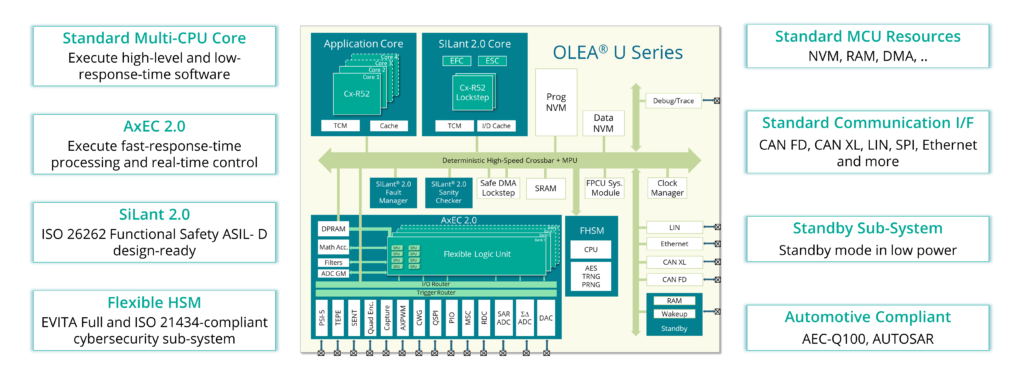Blog
OLEA U Series – FPCU Fundamentals
OLEA U Series – FPCU Fundamentals
OLEA U Series, strengthen the FPCU architecture
With the OLEA® U Series, Silicon Mobility continues to pursue the maturation of the FPCU architecture by multiplying its performance, enhancing its capabilities, and powering it with new advanced features.
The OLEA® U FPCU is a safe and secure automotive controller chip with a hybrid architecture and heterogeneous processing units. A technology that promises to redefine automotive electronic control.
In this article, we will dive into the definition and architecture of the FPCU and discover the main characteristics of the new chip.
Heterogenous processing with hybrid architecture
The hallmark of the FPCU is the integration of two distinct processing units, offering a strong complementarity in processing capability. The first unit is built around standard CPUs from the ARM Cortex-R family. This integration grants designers access to a vast ecosystem of third-party tools and software, including compilers, debuggers, profilers, system-C models, and a multitude of other resources. And that’s not all – The OLEA U® Series introduces multi-core clusters with up to 5 CPUs, creating a new dimension of multitasking and processing capabilities.
The second processing unit is the Advanced eXecution & Event Control (AxEC). It is a patented technology that combines programmable hardware, mathematical coprocessors, and configurable peripherals, all designed to interface directly with sensors and actuators. The programmable hardware is called the Flexible Logic Units (FLU) and lies at the heart of the FPCU architecture. It is a programmable logic fabric equipped with lookup tables, flip-flops, SRAM, and signal processing units, programmed using standard hardware description languages like Verilog or VHDL. The OLEA U® Series introduces the concept of multiple FLU partitions, ranging 1-4.
The AxEC unit is dedicated to executing fast- and deterministic response-time processing and real-time control, while the CPUs handle high-level application and low-response-time software. Designers have the flexibility to decide which parts of their control algorithms run on the CPU and which benefit from acceleration through AxEC. In most cases, CPUs are barely used as the AxEC takes on all the complex and demanding processing tasks. Furthermore, hardware processing ensures rapid eterministic precise, and consistent response times, regardless of the amount and the occurrence of events.
Both processing units have the same programming flexibility and can update firmware throughout the system life cycle. Development, debugging, and calibration processes remain seamless, as all variables and parameters manipulated by AxEC are observable and controllable, just like a CPU.
Safe
The FPCU is designed to meet ASIL-D design ready, the highest level of the automotive safety integrity level of the ISO 26262 functional safety standard. The Safety Integrity Level Agent (SILant®) is a patented technology embedded in the OLEA® U Series It is responsible for all the safety mechanisms that can detect, isolate, and respond to faults in nanoseconds. SILant® not only monitors latent and transient faults at the semiconductor level but also at the software and system levels.
With the introduction of multi-CPU and multi-FLU, OLEA® U FLU enables safe multitasking and function grouping with unified firmware virtualization from CPU down to FLU level. OLEA U has a deterministic architecture and guarantees Worst-Case Execution Time to design safety-critical applications.

Secure
The new generation of FPCU offers the highest protection against actual and future security threats. The Flexible Hardware Security Module (FHSM) is a sub-system embedded in OLEA® U Series compliant with EVITA Full and the ISO 21434 automotive cybersecurity standard. It has a dedicated processing subsystem, cryptographic accelerators and programmable hardware that can host custom hardware-accelerated security functions to enhance protection or monitor potential security breaches of the system. This unique feature enables secured software authentication, execution and updates and protected real-time communications using an extended span of cryptographic algorithms.
Automotive controller chip
Designers familiar with automotive microcontrollers will find all the standard system resources available in an FPCU. Dedicated to embedded applications, the OLEA® U Series includes up to 16MB of flash, SRAM, and standard communication interfaces such as CAN FD, CAN XL and Ethernet, fast debug, and trace interface for real-time calibration.
In the next article, we will take a closer look at the AxEC, its features and how it accelerates multiple closed-loop control.